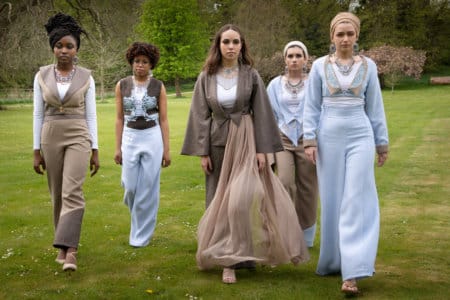Any creative profession requires dexterity, tenacity, and vision. It’s how beauty is created and problems are solved. The right university can equip you with all three — plus the power to use this trifecta to tackle some of the greatest challenges of our time. “Buckinghamshire New University (BNU) places a strong emphasis on fostering innovation and creativity within its design programmes through several key approaches,” says Hind Nasri, BA (Hons) Graphic Design with Foundation Year student.
There are programmes that cover various aspects of design, from traditional techniques to modern technologies; exposure that “encourages students to explore different avenues of creativity, gain a set of skills and supports research initiatives”; as well as the latest tools and software for students to explore innovative digital mediums and techniques.
“BNU has provided me with a comprehensive and forward-thinking education that has equipped me to effectively address the challenges and opportunities in today’s design industry,” she says. “Moreover, the university’s emphasis on sustainability has given me a deep understanding of the environmental and ethical considerations within design. This knowledge allows me to create solutions that align with global efforts towards sustainability.”
Often forgotten aspects in this field, social responsibility and sustainability take precedence at BNU. For the former, it is about promoting equality and embracing diversity to develop sustainable communities, whereas the latter is not just focusing on research and sourcing eco-friendly materials but also sustainable approaches in creative production. BNU ensures every student knows and commits to realising the United Nations Sustainable Development Goals in their everyday life.

At the School of Art, Design and Performance, students explore different computer software to bring their vision to life. Above: Hind Nasri’s Therapy App for diverse audiences. Source: Buckinghamshire New University
BNU does not just stop at awareness but fuses responsibility to people and planet in its curricula. In her second year, Nasri formed a brand identity for a charity that collects preloved toys in the UK and distributes them to African children in need, addressing toy waste and the importance of reusing. For her final major project called “Therapy App Design,” she developed an app that offers therapy while respecting diverse cultural backgrounds.
“I aim to leverage my design skills to develop innovative solutions that address real-world challenges,” says Nasri, who recently graduated. “Whether it’s through sustainable design practices, user-centred approaches, or the integration of emerging technologies, I aspire to contribute creative solutions that have a positive impact on society and the environment.”
Projects and outcomes like these are found across all School of Art, Design and Performance programmes; after all BNU’s design studies courses are ranked second for learning opportunities in the National Student Survey (NSS 2023). For Dan Gill, BA (Hons) Interior and Spatial Design student, the “A Home is not a House” and the Final Major Project in his third year were highlight projects that held environmental and social considerations at their core.
“The ‘A Home is not a House’ module was a complete building project, requiring a feasible sustainability strategy to be integrated into the building’s design,” he says. “Emphasis was placed on reducing the environmental footprint of a building and its impact on the surrounding natural environment.” Gill designed a climate museum for his Final Major Project to raise awareness of the impact of climate change and the impact of rising sea levels on coastal communities.
The art & design degrees in this School give students the technical know-how to thrive in their field, implementing hands-on traditional approaches as well as navigating industry-standard digital technologies. The BA (Hons) Interior and Spatial Design course trains students to produce technical drawings, 3D models and presentation material, as well as makes them proficient in computer software such as AutoCAD, Rhino and Adobe. “These industry-recognised skills can be applied to a variety of design projects, ranging from small interior-based projects to larger, more architectural projects. I ended up designing entire buildings, including a climate museum,” says Gill.

Sustainability is one of the key tenets at BNU’s School of Art, Design & Performance. Above: An example of Dan Gill’s models for Interior and Spatial Design. Source: Buckinghamshire New University
Workshops and guest lectures exposed Tia Daley, a BSc (Hons) Sustainable Product Design student, to state-of-the-art equipment and leading industry professionals. And by exhibiting at “New Designers,” she got to speak to judges, industry professionals, manufacturers and recruiters. “During New Designers I was shortlisted for two awards, and my classmates were offered internships, job opportunities, the ability to mass-produce their products, and a feature in Dezeen,” she says. “I witnessed the high level of work that is being produced by graduates, which in turn shed light on who I can collaborate with, who I will be competing for jobs and who I may be working with in the future.”
It’s an experience she feels “extremely lucky” to be part of — just like the projects that got her to put environmental impact and action on social issues first. “The assignment that highlighted sustainability to me was the furniture up-cycling project I completed in my second year. During this project, students went to a charity shop and chose a piece of furniture to take and upcycle. I chose an old oak bedside table with cigarette burns,” she says. “The project aims to update old furniture by adding new features rather than buying new furniture and using more natural resources. I used half-dowels, veneer, stain and Osmo oil to add value and aesthetic features to the product.”
Start your sustainable design journey at the Buckinghamshire New University, click here to apply now.
Follow Buckinghamshire New University on Facebook, Twitter, LinkedIn, Instagram, YouTube, and TikTok.













